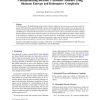Free Online Productivity Tools
i2Speak
i2Symbol
i2OCR
iTex2Img
iWeb2Print
iWeb2Shot
i2Type
iPdf2Split
iPdf2Merge
i2Bopomofo
i2Arabic
i2Style
i2Image
i2PDF
iLatex2Rtf
Sci2ools
CAE
2007
2007
Conceptualizing Birkhoff's Aesthetic Measure Using Shannon Entropy and Kolmogorov Complexity
In 1928, George D. Birkhoff introduced the Aesthetic Measure, defined as the ratio between order and complexity, and, in 1965, Max Bense analyzed Birkhoff's measure from an information theory point of view. In this paper, the concepts of order and complexity in an image (in our case, a painting) are analyzed in the light of Shannon entropy and Kolmogorov complexity. We also present a new vision of the creative process: the initial uncertainty, obtained from the Shannon entropy of the repertoire (palette), is transformed into algorithmic information content, defined by the Kolmogorov complexity of the image. From this perspective, the Birkhoff's Aesthetic Measure is presented as the ratio between the algorithmic reduction of uncertainty (order) and the initial uncertainty (complexity). The measures proposed are applied to several works of Mondrian, Pollock, and van Gogh. Categories and Subject Descriptors (according to ACM CCS): I.4 [Computing Methodologies]: Image Processing...
| Added | 30 Sep 2010 |
| Updated | 30 Sep 2010 |
| Type | Conference |
| Year | 2007 |
| Where | CAE |
| Authors | Jaume Rigau, Miquel Feixas, Mateu Sbert |
Comments (0)

